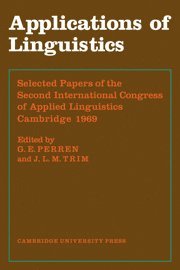
- Format
- Inbunden (Hardback)
- Språk
- Engelska
- Antal sidor
- 516
- Utgivningsdatum
- 1971-08-01
- Förlag
- Cambridge University Press
- Medarbetare
- Trim, J. L. M.
- Illustrationer
- d.tabs.
- Dimensioner
- 200 x 100 x 10 mm
- Vikt
- Antal komponenter
- 1
- ISBN
- 9780521080880
- 1030 g
Applications of Linguistics
Papers
Slutsåld
Kundrecensioner
Innehållsförteckning
Foreword; Editors' introduction; Part I. Papers from Plenary Sessions: 1. Applications of linguistics; 2. The uses of sociolinguistics; 3. Technological development for language learning; 4. Applied computational linguistics; 5. La neurolinguistique; 6. Linguistic factors in communications engineering; Part II. Papers from Specialist Sections: 7. Language and attitudes of the Spanish-speaking youth of the Southwestern United States; 8. Some comparative descriptions of children's language; 9. Cross-level interference: the influence of L1 syllable structure on L2 morphological error; 10. Some psycholinquistic considerations involved in a language-testing project; 11. A suggested rationale for the treatment of developmental disorders of language; 12. Language testing in the primary school; 13. The Radio Brighton pilot project: an experiment in teaching languages by radio and telephone; 14. The reliability of the essay subtest in a university entrance test in English for non-native speakers of English; 15. Tensions of television course-writing; 16. Aptitude for and proficiency in French in the first year of the UK secondary school; 17. Linguistic observations on the heroic couplet in English poetry; 18. The use of the Dvanagari script as a phonemic notation for the teaching of English pronounciation in North India; 19. Analyse lectronique de textes litteraires applique ... la lexicographie en Italie; 20. Bruit et perception auditive (tude experimentale); 21. Applications of behavioural technology: from conventional lab teaching to technological total self-instruction; 22. Distinctive features and phonetic dimensions; 23. Learning and re-learning articulartory skills; 24. Grammaires d'enfants agrammatiques; 25. An error analysis in German of first-year university students; 26. Analysis of decoding impairments in dysaphasic subjects; 27. Three experiments in the use of VTR in language teaching; 28. Children's use of categorisation in remembering verbal material; 29. Teaching syntactic maturity; 30. Preliminary recommendations of the Swedish research project on language laboratories in university teaching: an interim report; 31. Some temporal factors in the listening behaviour of second language students; 32. Static and dynamic lexical systems; 33. A quantitative theory of cardinal vowels and the teaching of pronounciation; 34. L'apport de la radio dans l'enseignement du franais ... l'cole primaire sngalaise; 35. Contrastive analysis of the Hungarian and Serbocroation noun phrase; 36. Semantic components in translation theory; 37. Language varieties along the US-Mexican border; 38. Talking to some purpose (choosing the language-teaching points of the Nuffield/Schools Council German course; 39. Limites des applications de la linguistique ... la lexicographie; 40. A new concept of the language laboratory and its application to research and the development of proficiency in language learning; 41. Reduced redundancy as a language testing tool; 42. A ...
Du kanske gillar
-
Proto
Laura Spinney
Häftad -
Artist's Way
Julia Cameron
Häftad -
On Writing
Stephen King
Häftad -
Into The Woods
John Yorke
Häftad
